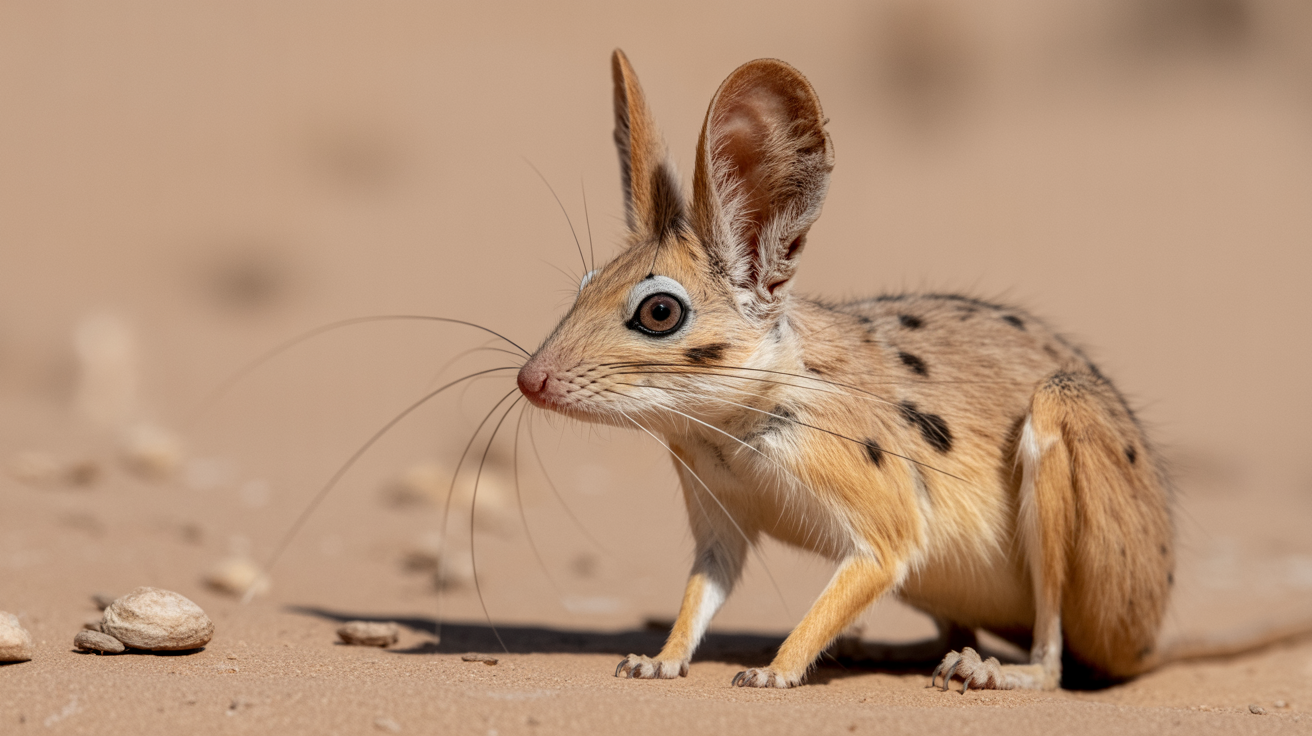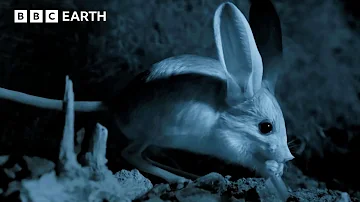
Lesser Egyptian Jerboa
Jaculus jaculus

Meet the Lesser Egyptian Jerboa
The Lesser Egyptian Jerboa is a small, nocturnal rodent known for its extraordinary long hind legs and tail, which help it leap several feet in a single bound. Adapted to arid desert environments, it spends the hot days in deep burrows and emerges at night to forage. With large eyes and ears, the jerboa has excellent hearing and vision for detecting predators in the dark. Its fur is sandy-colored, providing effective camouflage against the desert landscape. Jerboas are uniquely specialized for survival in some of the harshest environments on Earth.
Classification
Mammal
Habitat
Desert
Diet
Herbivore
Lifespan
2-6 years
Conservation
Least Concern
Weight
24-38 grams
📖Fascinating Facts
Incredible Jumpers
Jerboas use their powerful hind legs to escape predators, jumping distances up to 10 times their body length.
Desert Adaptation
They spend daylight hours in deep burrows to avoid the extreme heat and only emerge at night to forage.
Sensitive Senses
Their large ears provide acute hearing, helping them detect approaching predators in the silence of the desert night.
📋Detailed Description
The Lesser Egyptian Jerboa (Jaculus jaculus) is a small, highly specialized rodent, typically measuring 9–10 cm in head-body length, with a tail extending 12–16 cm, often tipped with a distinctive tuft of black or white fur. Its most notable anatomical features are its disproportionately long hind limbs and reduced forelimbs, adaptations that enable powerful, bipedal leaps of up to 3 meters, facilitating rapid escape from predators and efficient travel across sandy substrates. The skull is relatively large with pronounced auditory bullae, enhancing its acute hearing, while the eyes are prominent and adapted for nocturnal vision. The fur is dense, silky, and sandy to pale brown dorsally, blending seamlessly with arid landscapes, while the underparts are white. Jerboas possess a short, blunt snout with long vibrissae (whiskers) that aid in tactile navigation at night. Their dental formula is adapted for granivory, with ever-growing incisors and reduced cheek teeth. Behaviorally, they are solitary and territorial, constructing complex burrow systems up to 2 meters deep to avoid extreme daytime temperatures and predation. These burrows often have multiple entrances and are sealed during the day to conserve moisture. The species exhibits seasonal torpor during the coldest months, reducing metabolic demands. Reproduction is seasonal, with females producing 2–3 litters per year, each comprising 2–6 altricial young. The jerboa’s unique morphology and behaviors represent a remarkable evolutionary response to the challenges of desert life.
💡 Did you know?
Despite their mouse-like appearance, jerboas are more closely related to jumping mice and birch mice than to true mice or rats.
🔬Research & Sources
Wikipedia Summary
The lesser jerboa is a small rodent of Africa and the Middle East. Its diet consists mainly of seeds and grasses.
Last Modified: 1/10/2025
🎭Behavior & Social Structure
Lesser Egyptian Jerboas are strictly nocturnal, emerging from their burrows shortly after sunset to forage. Their locomotion is characterized by saltatory (jumping) movement, which not only conserves energy but also reduces contact with hot sand and deters predators such as owls, foxes, and snakes. Foraging is primarily solitary, with individuals using their sensitive vibrissae and acute sense of smell to locate seeds, grasses, and occasionally insects. They exhibit food hoarding behavior, storing seeds in cheek pouches to transport them back to the burrow. Jerboas communicate through foot-drumming, vocalizations, and scent marking, particularly during the breeding season. Social interactions are generally limited to mating and, occasionally, brief encounters at overlapping foraging territories. During the day, they remain inactive in sealed burrows, where humidity is higher and temperatures are stable, minimizing water loss and thermal stress.
👶Reproduction & Life Cycle
Breeding in Jaculus jaculus is typically synchronized with periods of increased food availability, often following seasonal rains. Mating occurs from March to October, with peak activity in spring and early summer. After a gestation period of approximately 25–35 days, females give birth to 2–6 young per litter. The offspring are born hairless and blind, remaining in the safety of the burrow for the first 4–5 weeks. Maternal care is pronounced, with the female nursing and grooming the young until weaning. Juveniles reach sexual maturity at around 8–10 weeks of age. Multiple litters per year are common in favorable conditions, contributing to the species’ resilience in fluctuating environments.
🛡️Adaptations & Survival
The Lesser Egyptian Jerboa exhibits a suite of adaptations for desert survival. Its elongated hind limbs and reduced forelimbs facilitate rapid, energy-efficient bipedal locomotion, minimizing time spent on the hot sand. The large auditory bullae amplify low-frequency sounds, aiding in predator detection. Nocturnality and deep burrowing behaviors reduce exposure to extreme temperatures and desiccation. The kidneys are highly efficient, producing concentrated urine to conserve water, and the animal derives most of its moisture from food, rarely drinking free water. The sandy coloration provides camouflage, while the tufted tail aids in balance during high-speed jumps. Behavioral adaptations include food hoarding, seasonal torpor, and the ability to seal burrow entrances to maintain stable microclimates.
📚Research Sources
🎨Cultural Significance
The jerboa has been referenced in various Middle Eastern and North African cultures, often symbolizing agility, resilience, and adaptation to harsh environments. In ancient Egyptian art and folklore, small desert rodents like the jerboa were sometimes depicted as symbols of fertility and survival. While not a major component of traditional diets or medicine, jerboas have occasionally been kept as pets and are subjects of local curiosity due to their unusual appearance and remarkable jumping ability.
🔬Recent Research & Discoveries
Recent genetic studies have clarified the taxonomic relationships within the genus Jaculus, revealing cryptic diversity and potential subspecies. Ongoing research focuses on the jerboa’s locomotor biomechanics, with insights into bipedal evolution and energy conservation in arid environments. Physiological studies have examined renal adaptations to water scarcity, while ecological research investigates the species’ role in seed dispersal and desert ecosystem dynamics. Conservation monitoring is ongoing in regions experiencing rapid land-use change, with population genetics informing management strategies.
🎥Wildlife Videos

Desert Fox Hunts A Lesser Jerboa | Wild Arabia | BBC Earth
Welcome to BBC EARTH! The world is an amazing place full of stories, beauty and natural wonder. Here you'll find 50 years worth ...
BBC Earth

The Mini "Kangaroo" of the Sahara | Wild Egypt
About National Geographic Wild: National Geographic Wild is a place for all things animals and for animal-lovers alike. Take a ...
Nat Geo Animals

The Jerboa Is A Remarkable Little Rodent | Asia Fun Facts | BBC Earth Kids
What do you get if you mix the body of a mouse, the ears of a rabbit and the back legs of a kangaroo? You get the jumpiest critter ...
BBC Earth Kids

Jerboa Journeys|Surviving the Desert Sands|Jumping Jerboas
... lesser egyptian jerboa jerboa long eared scorched earth jerboa long eared jerboa pet bbc earth jerboa jerboa documentary ...
Being Creatures

Magic of the Moors - A Mysterious World Full of Life | Free Documentary Nature
Magic of the Moors - A Mysterious World Full of Life | Wildlife Documentary Watch 'Wild Germany: The Mecklenburg Lake Plateau' ...
Free Documentary - Nature

Jerboas: How This Furry T-Rex Survives the Desert
Life can be pretty tough in the desert, especially when everyone is trying to eat you. But when you're born with hind legs that are ...
Crazy Creatures
🌍Habitat Information
The Lesser Egyptian Jerboa typically inhabits Desert environments. Lesser Egyptian Jerboas have adapted to their environments with specialized features and behaviors.
Primary Habitat:
Desert
More detailed habitat information will be available soon.
🛡️Conservation Status
The Lesser Egyptian Jerboa is currently classified as Least Concern. Conservation efforts are crucial for preserving this species for future generations.
Common Threats:
- 🏠Habitat loss and fragmentation
- 🌡️Climate change impacts
- 🎯Hunting and poaching
- 🏭Human-wildlife conflict
⚠️Threats & Conservation Challenges
Currently listed as Least Concern by the IUCN, the Lesser Egyptian Jerboa faces localized threats from habitat degradation due to agricultural expansion, overgrazing, and infrastructure development. In some regions, populations are impacted by pesticide use and predation by introduced species. Climate change poses a long-term threat through alterations in precipitation patterns and increased temperature extremes, potentially affecting food availability and burrow microclimates. Despite these challenges, the species’ wide distribution and high reproductive rate contribute to its overall population stability.
🔬Scientific Classification
Scientific Name
Jaculus jaculus
Classification Hierarchy
🔍 About Taxonomic Classification
Taxonomic classification is a hierarchical system used by scientists to classify and organize living organisms based on shared characteristics and evolutionary relationships.
The system moves from broad categories (Kingdom) to increasingly specific ones, with each animal's scientific name typically consisting of its Genus and species.
📝Community Notes
Share your observations and insights about the Lesser Egyptian Jerboa with our community of wildlife enthusiasts.
Join Our Community
Sign in to share your observations and connect with fellow wildlife enthusiasts.
Sign In to ContributeNo community notes yet
Be the first to share your observations about the Lesser Egyptian Jerboa!
Explore Lesser Egyptian Jerboa
Select a tab above to learn more about this amazing animal.
📸Photo Gallery
No photos available for this animal yet.
🌟Discover More Wildlife
Continue your journey of discovery with more fascinating animals from our database
